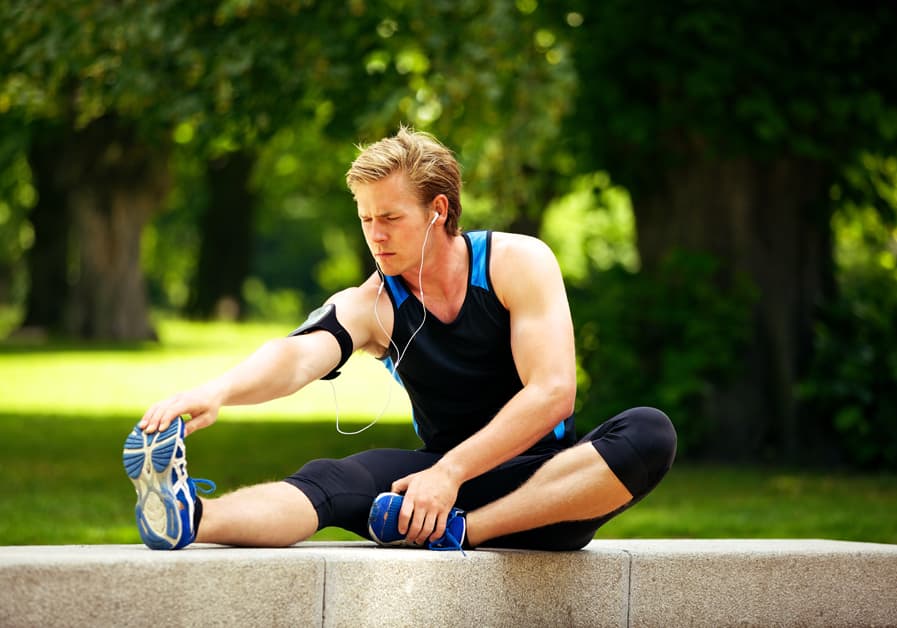Pre-Workout Warm-up
Before exercising, it is important to warm up. This can help prevent injury, especially for those who suffer from knee pain. So, a proper pre-workout warm-up is key. Here are some tips for warming up in the morning to reduce knee pain:
- Stretch your muscles.
- Do light exercises like jogging in place.
- Do some dynamic stretches.
- And, don’t forget to hydrate!
Low-impact cardio exercises
Knee pain sufferers, try a pre-workout warm-up! Low-impact cardio exercises are great for this. Examples include swimming, cycling, elliptical machines, rowing machines, and walking.
These exercises get your heart rate up and help you build strength in the legs. This increases balance and flexibility. Plus, it helps reduce the risk of knee pain or injury when doing other activities.
To get the best results, warm up for at least 10 minutes before your workout routine. Start out slow and gradually increase intensity. Move at a level that’s comfortable for you.
Also, consider adding static stretches. They can help prepare muscles for activity and reduce the chances of strain or injury.
Dynamic stretching
Dynamic stretching is an awesome pre-workout warm-up. It helps improve range of motion, reduce the risk of injury, and prepare the body for more strenuous activity. You do carefully planned and controlled movements that target muscle groups. For example, you could raise your arms up behind your back or swing your legs from side to side.
Unlike static stretching, dynamic stretching uses small, controlled movements that gradually increase in range as the muscles warm up. This warm-up also helps athletes boost agility and flexibility. They can then move faster and more accurately during exercise or sports.
Dynamic stretching is best with low-intensity exercises, but can also be done with high intensity activities like jogging and skipping. Common dynamic stretches include:
- Walking lunges
- High knees
- Butt kicks
- Jumping jacks
- Arm circles
These should be part of a pre-workout warm-up routine. It will help maximize performance and lower the risk of injury.
Foam rolling
Foam rolling is essential for pre-workout warm-ups if you suffer from knee pain. Place the roller on the ground and rest your body weight on it. Roll slowly and pulsing up and down your legs. This increases blood flow and stretches tight muscles. If an area feels particularly tight, hold it for 1 minute. It helps realign joints and relieves muscle fatigue or stress.
Static stretching is also good to do before a workout. Do calf, quad and hamstring stretches one leg at a time. Hold each stretch for 20-30 seconds. Don’t push yourself beyond what’s comfortable – it could worsen existing injuries.
During-Workout Warm-up
Knee pain can be really tough for those who exercise, especially in the morning. Warm-up is vital! It decreases muscle stiffness and boosts flexibility. It also reduces the chances of getting hurt whilst exercising, especially knee pain.
Let’s explore the significance of warm-up tips to avoid knee pain:
Warming up with weights
Use weights to warm up! This is a great way to get your body ready to work out. It increases core temperature and helps protect against injuries.
Don’t go too hard though, or for too long. You don’t want to tire yourself out before you even start your exercise routine. Do bear crawls, glute bridges, arm circles, leg swings and side shuffles. You can use light weights if desired.
Stretch too – hold each stretch for 30 seconds or longer. Do two easy sets for each muscle group you’ll use. 10 light squats or bench presses should do it.
Rest before your workout. Use this time to get mentally focused for the task ahead. Warming up with weights will help make sure that happens!
Proper form and technique
Before beginning any physical activity, it is essential to warm up. This increases heart rate & body temperature, making muscles & ligaments more elastic & flexible. Dynamic stretching should be the focus, & should not take away too much time or energy. Movements like arm circles & leg swings can help to stretch large muscle groups such as the chest, hamstrings, quads & back. This reduces risk of injury by increasing range of motion. However, holding stretches too long or without gradually increasing intensity may actually limit gains instead of improving them.
Light cardio is also beneficial for warm-ups. This further increases blood flow – brisk walking, cycling or jogging are great options. Warm-ups should not be overlooked when planning any activity. Proper form & adequate rest throughout should always be taken into account for safety, increased performance & reduced fatigue during workouts.
Slow and controlled movements
Before you start your workout, make sure your muscles are ready with a slow and controlled warm-up. Taking 5-10 minutes for some low-impact aerobic exercise and dynamic stretching will fire up your cardiovascular system. This loosens muscles and improves joint movement.
Slow and controlled movements can help you avoid serious muscle damage. Cardio such as walking, jogging or biking can increase your heart rate. Dynamic stretching is also important. This uses active movements that imitate the exercises you plan to do, rather than just stretching a single muscle group. This helps your body learn how to move better.
Remember ‘the slower the better’. Spend a little extra time at the start and end of your routine. Do 5 minutes of dynamic stretching and 5 minutes of low-impact aerobic exercise. This will help you get the most out of your strength training and minimize risk of injury.
Post-Workout Warm-up
Warm-ups before a workout are key! Especially for those with chronic knee pain. A warm-up prepares the joints and muscles for exercise. It lowers the risk of injury and knee pain – especially in the morning.
Here are some tips for a successful morning warm-up:
Cool down exercises
Cool down exercises are just as important as warm-up exercises. They help reduce muscle tension, prevent dizziness and aches, and speed up recovery time. There are five key elements of a good cool down routine: stretching/flexibility; balance; core; relaxation; and mindfulness.
- Stretching/Flexibility: Keep muscles supple. Do static (hold one position for 10-30 seconds) or dynamic stretching (move while holding a stretch).
- Balance: Increase stability, coordination, and body awareness. Stand on one foot while lifting the other off the ground. Use a balance board or Bosu ball.
- Core: Strengthen abdominal muscles. Examples are planks and sit-ups.
- Relaxation: Lower cortisol levels. Take breaks from exercise to do deep breathing.
- Mindfulness: Become aware of physical senses. Tune into how you feel. Avoid overtraining/burnout. Slow down heart rate for quicker recovery.
Stretching
Stretching is an essential post-workout warm-up. It helps reduce tension in tired muscles and stiffness in joints. Hold each stretch for 15-30 seconds, and repeat three times.
These simple stretches can help relieve knee pain before and after exercise. For a quad stretch, stand on one leg, bend the other leg behind you and hold your ankle or lower leg with your hand. Gently pull your heel towards your glutes, keeping a straight torso.
For a calf stretch, stand facing away from a wall or object for balance. Prop up one foot with toes forward. Gently press the heel towards the floor until you feel tension in the back of the calf muscle and plantar fascia at the bottom of your foot.
- Sit on an exercise foam roller placed perpendicular under each hip. Keep your knees bent to not irritate them while holding this position 15-30 seconds. Move down to target different muscles.
- Shoulder rolls are important too. Circle each shoulder twice clockwise, and reverse direction counterclockwise two more times. Repeat on both sides.
Ice application
Ice application is great for recovery post-workout. It reduces inflammation and offers instant pain relief. It can also speed up healing.
When using ice, it’s important to apply it properly. Use it in combination with compression and elevation. This may help reduce swelling and pain even further. Talk to a medical professional before using any recovery techniques or methods.
To ensure safe usage, follow these steps:
- Wrap an ice pack in a towel or cloth before applying it to the skin.
- Put the pack on the affected area for 15-20 minutes. Don’t leave it on too long as this can lead to skin damage or injury.
- Check regularly for discoloration or numbness.
- If you experience more discomfort, stop immediately and talk to a medical professional.
Additional Tips
Warming up can stop injury and knee discomfort, but there are more tips for those who work out in the morning. Here are a few ideas to have a secure and successful exercise session:
- Start with some light stretching and a few dynamic exercises.
- Gradually increase the intensity of your workout.
- Don’t forget to hydrate and fuel your body.
- Listen to your body and take breaks when necessary.
- Cool down after your workout.
Wear supportive gear
Serious coffee roasters must wear proper clothing and protective gear. Pockets of flames, hot surfaces, and hazardous chemicals make it essential to wear long pants, close-toed shoes with strong soles, and shirts or jackets with long sleeves. It’s wise to also wear gloves. For extra safety, many pros wear a full face shield. Investing in a fire retardant suit is also an excellent idea.
Don’t underestimate the intensity of flame in coffee roasting – take all the necessary precautions first!
Stay hydrated
Hydration is key for improving mobility and reducing morning stiffness. Dehydration affects joints, so drinking fluids all day – especially first thing in the morning – helps keep them lubricated and moving easier. Aim for 64 ounces of water per day – or more depending on body size, activity level, etc.
Electrolytes like sodium and potassium can also help with stiffness due to their mineral content which supports joint cushioning. Electrolyte-rich drinks are especially useful after exercising heavily or after spending time in hot places like gyms and saunas, as they can cause higher levels of dehydration.
Listen to your body
Listen to your body and watch out for signs of pain. If you feel pain or unease, stop what you’re doing or modify your movements. Be aware of any activity or position that causes knee pain.
Before exercising, take a couple of minutes to relax the muscles around your knees. You can do this with stretching, foam rolling, or dynamic stretches with a resistance band. Rolling out the muscles near the knee, like the IT band and glutes, can help reduce pain.
Warm-up exercises are essential for preventing knee pain when working out in the morning. Start with a 10-15 minute walk or jog. Then do some light stretching, like side stretches or quadricep stretches. Include some light yoga poses, like child’s pose. Make sure to wear cushioned shoes for support. Remember to stay hydrated with water throughout your workout. Before doing any new exercise program, always talk to your healthcare provider!
Frequently Asked Questions
Q: What are some tips for warming up with knee pain?
A: Some tips for warming up with knee pain include: stretching gently, doing dynamic warm-ups such as leg swings, walking with a light jog, and foam rolling the affected area.
Q: How long should I warm up before working out?
A: You should warm up for at least 5 to 10 minutes before working out. This will help to get your body ready for the workout and reduce the risk of injury.
Q: What should I do if I’m still in pain after warming up?
A: If you’re still in pain after warming up, it’s best to stop and rest. If possible, consult with a doctor or physical therapist to develop an appropriate warm-up and exercise plan that takes into account your existing knee pain.





